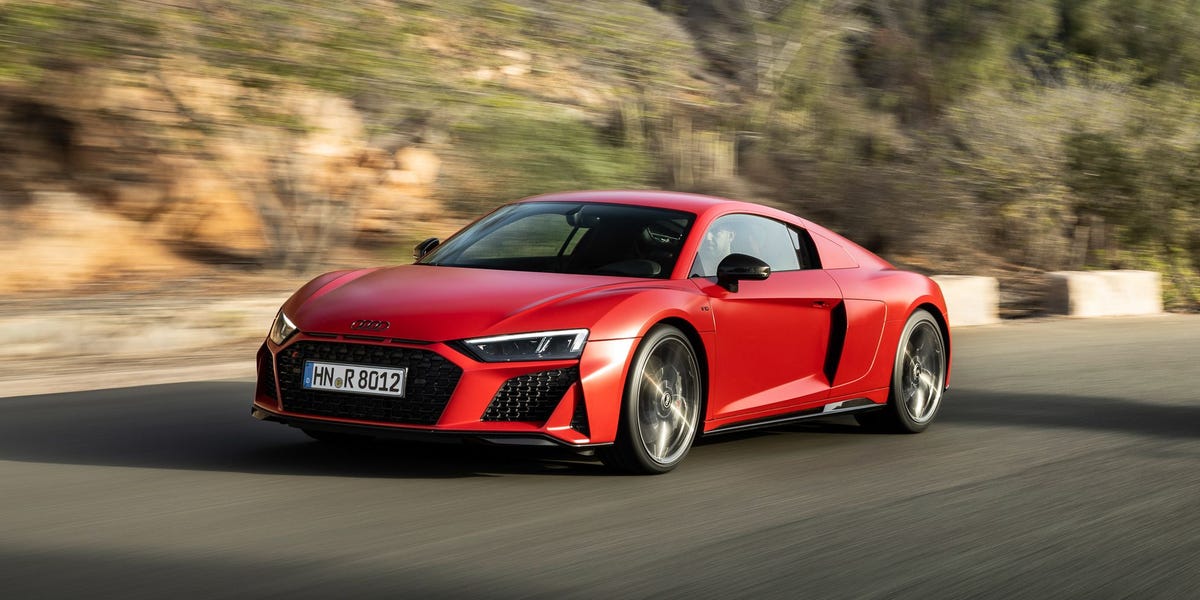
Does anything sound better than a hardworking V-10? The question was raised and subsequently answered by the combination of a freeway tunnel on the Spanish island of Gran Canaria and the R8 Performance Spyder’s 8700-rpm redline, experienced with the roof down. The noise is both glorious and entirely free of digital augmentation—savage exhaust harmonics overlaying the mechanical thrash of the naturally aspirated engine, busier and harder-edged than a V-8, angrier than a V-12.
We will miss it when it’s gone, which it will be all too soon. Both the R8 and the closely related Lamborghini Huracán are most of the way to retirement, and the V-10 engine they share—the last offered in any current production cars—is set to die with them. Audi is working on an all-electric replacement for the R8, and Lamborghini is developing a hybridized twin-turbo V-8 for the Huracán’s successor. It isn’t time to write the R8’s obituary yet, but the pared-back model range proves the clock is ticking.
Because Audi dropped the former entry-level rear-driven R8 and replaced it with the Performance derivative, the R8 selection is now a pair of binary choices: whether drive is delivered through two or four wheels, and whether the car is ordered with a fixed or fabric roof.
The new rear-drive Performance is distinguished from the Quattro by more than just a reduction in driveshafts. It uses a 562-hp version of the 5.2-liter V-10, a 30-hp increase over the output of the former RWD base, but still 40 horsepower shy of its AWD sister. The two-wheel-drive car also does without the carbon-ceramic brakes, 20-inch wheels, carbon-fiber side blades, and laser headlights that the Quattro gets as standard. It is possible to correct all of these omissions with option packs, although doing so will split the $51,100 gap between the two versions.
Audi portrays the RWD Performance as a more dynamic choice, although its purity of purpose is due in large part to cost-saving measures. Unusually for this part of the market, it rides on passive rather than adaptive dampers and delivers power to the rear wheels through a conventional limited-slip differential rather than an electronically controlled unit.
Losing the center differential and front driveshafts saves only a modest 110 pounds of mass, according to Audi’s engineers, and doesn’t transform the car’s character at everyday speeds. Powering out of slower corners, the Performance reaches the point of traction-control intervention more quickly than the Quattro, but that intervention is unobtrusive. In Comfort mode, there’s simply an invisible guardrail preventing power oversteer.
Selecting the more aggressive modes raises the intervention threshold and allows more rear-end slip, especially with the track-biased Performance setting that comes with the optional Sport Exhaust package. But the chassis is better at finesse than outright hoonery. Even at speeds that feel mighty quick on Spanish mountain roads, the Spyder’s cornering line is more easily adjusted by gentle accelerator inputs and weight transfer between the axles rather than trying to overpower the rear Michelin Pilot Sport 4S tires.
The chance to drive a RWD Coupe on the tight, technical Maspalomas circuit (with spectacular views over the Atlantic Ocean) provides higher lateral loads abetted by a switch to more aggressive Michelin Pilot Sport Cup 2 tires. Safely removed from public roads, the Performance could be made to feel distinctly loose when pushed hard. This was especially true when a rain shower turned the track slick and made careful throttle management even more important—yet the R8 still felt happier being driven within its limits than at the edge of them.
Steering feel remains the R8’s weak link. Both cars we drove had the variable-ratio Dynamic rack, which will be a $1400 option in the U.S. The Coupe’s front end is impressively crisp on the circuit, and the Spyder makes light work of the many hairpin bends on Gran Canaria’s mountain roads, but feedback in both is distant and muted. The Coupe was also fitted with the intriguing option of a front carbon-fiber anti-roll bar—an $1100 extra that both saves 4.4 pounds of weight and is claimed to sharpen front-axle responses.
While little changed from its previous incarnations, the V-10 remains the R8’s star feature. It lacks low-down torque compared with turbocharged rivals, but compensates with strong, linear urge all the way to its altitudinous redline. As in other R8s, the Performance remains muted at lower revs, exuding a very different aural character from the always-shouty Lamborghini Huracán. But as engine speed rises, the Audi finds its voice. Well before it reaches its 8700-rpm redline, the Performance sounds more compelling than most supercars do at any engine speed. That’s despite that the exhaust systems of the Euro-spec cars on the launch were slightly muted by gasoline-particulate filters that won’t come to the U.S. The $3600 Sport Exhaust package should probably be regarded as a must-have.
The R8 remains a bit unsure of whether it’s a luxury sports car or a supercar, and it’s often trying to downplay the theatricality of its spectacular powerplant. The RWD Performance is now the entry level for the range, and the $151,895 starting price ($164,095 for the Spyder) is likely to be a bigger part of its appeal than its slightly enhanced potential for power oversteer. Yet even with a slight sticker increase over the old base RWD car, it still looks very well priced considering the inherent magic of that V-10 engine. We will surely miss it when it is gone.
This content is created and maintained by a third party, and imported onto this page to help users provide their email addresses. You may be able to find more information about this and similar content at piano.io
